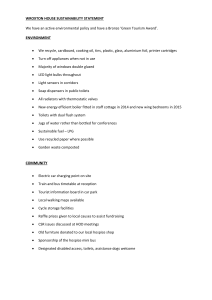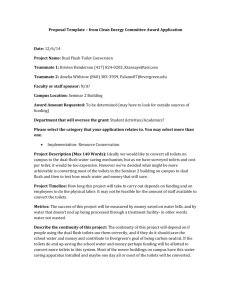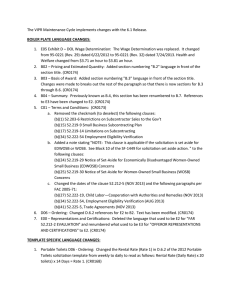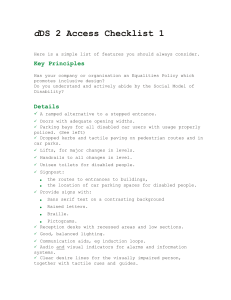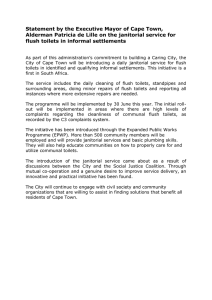Equality Impact Assessment Record Form
advertisement
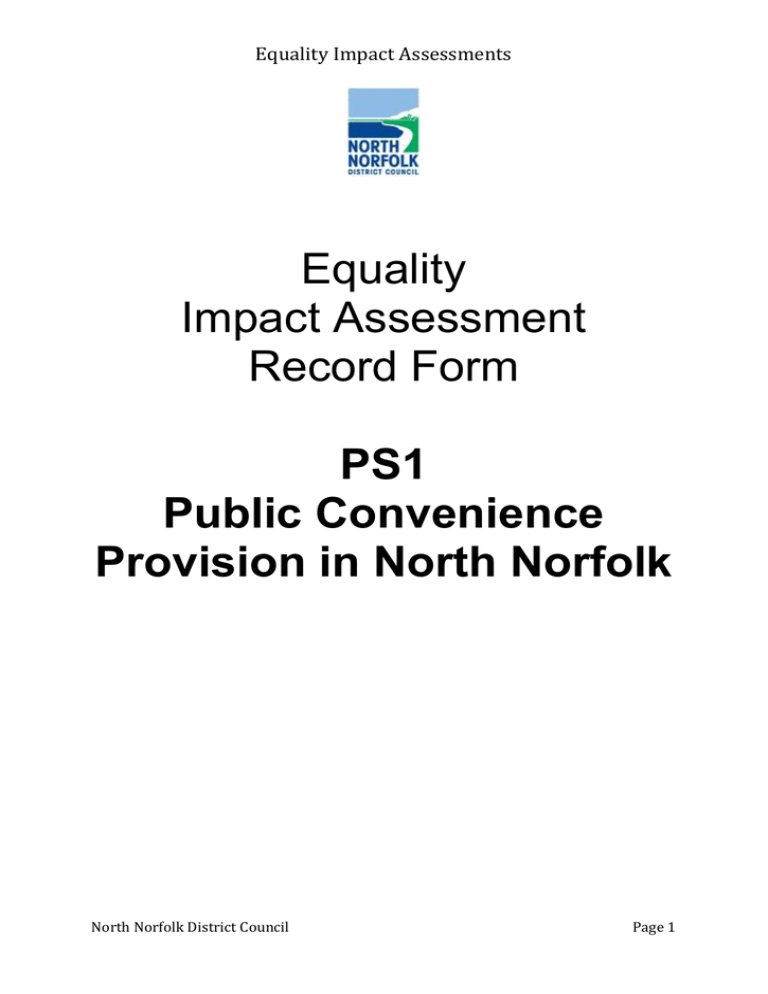
Equality Impact Assessments Equality Impact Assessment Record Form PS1 Public Convenience Provision in North Norfolk North Norfolk District Council Page 1 Equality Impact Assessments PS1 TOILETS Directorate Service Person Date responsible for assessment the assessment completed Resources Property Services Corporate Assets Manager Title of the assessed facility being The status of the facility North Norfolk District Council Public Convenience provision in North Norfolk The Council owns and maintains 41 public toilets blocks across the district, with highest concentrations in the seaside resorts. The nature of the district, with high numbers of visitors means that provision of public toilets is critical to the tourism industry. However, poor quality facilities lead to poor image, and the cost of provision is significant. A programme of capital investment to the value of £470,000 was agreed at Cabinet September 2008. This was in addition to provision of new toilets at Sea Palling and the North Norfolk Information Centre in Cromer. The programme which will take place over 2009 and 2010 involves upgrade and refurbishment to 28 blocks. This will bring the assets up to a point 34 blocks are DDA compliant and 34 reach the mobility standard compliant with part M Building regulations 2004 and BS 8300:2009, design of buildings and their approaches to meet the needs of disabled people. See Schedule in Appendix 1. There is currently no formal policy for Public Conveniences, but the Asset Management Plan 2009 will contain a Public Convenience Strategy in order to provide a framework for future decision making on investment. The toilets are cleaned under contract by Norse, and this contract is up for re-tender during 2009/10, with the new contract due to commence April 2011. The toilets are maintained by the Council’s Property Services team who are managing a programme of improvements. Page 2 1. What are the aims, objectives and purposes of the policy? 2. Does the policy support other objectives of the council? 3. Who is intended to benefit from the policy, and in what way? 4. What outcomes are anticipated from the facility 5. Identify and select your assessment team. The objective of the public convenience strategy is to provide good quality, clean, accessible, well-maintained toilets that people want to use, within the Council’s budgetary constraints. The intention will be to move towards more energy and water efficient facilities and to provide for DDA compliance and mobility standards where possible. This will support the tourist economy as well as providing an important facility for local people. This will be measured in terms of complaints. If additional resources are available other measures will be investigated. The provision of public conveniences and the improvement programme should improve the tourism offer and enhance the built environment, thereby supporting objectives around environment and jobs. All members of the public who use public toilets and the wider community in terms of how public toilets support the tourist economy. North Norfolk District Council from a reputational point of view. Improved service to public, improved image of North Norfolk towns and resorts, reduced number of complaints, increased number of compliments, reduced liability and increased numbers of repeat tourist visitors. Public conveniences are an important aspect of the tourist offer in all our resorts and market towns, but particularly in the seaside resorts. Also need to ensure reduced maintenance costs and ease of cleaning in new and improved facilities. Provision of hot water and shower facility at Mundesley Prom will significantly improve hygiene. Name Corporate Asset manager Capital Programme Project manager Role Responsibilities Overall management of service Project manages works Manages toilet cleansing contract 3 6. What data have you gathered for this assessment? How have you analysed this data? 7. Who are the main stakeholders of this policy? 8. Are there any concerns that the policy could have a negative impact with regard to race and ethnicity? 9. Are there any concerns that the policy could have a negative impact with regard to gender? 10.Are there any concerns that the policy could have a negative impact with regard to disability? Source and Age of Data Letters of complaint On-going Access Assesment Owner No No Yes Data Gaps PS PS Community Local community visitors Findings and See assessments for each block Staff/Members Partners Town and parish councils, enhancement groups, local business What evidence (actual data or assumptions) do you have to support this? There is no evidence to suggest that there are issues regarding race and ethnicity, particularly given the relatively small BME resident and visitor population. This issue is not currently monitored. What evidence (actual data or assumptions) do you have to support this? There is adequate provision for both genders and provision for each gender is based on historical use, national standards and predicted use. Provision between genders if different reflecting different needs. Provision of baby changing facilities is available to both genders in all refurbishments. What evidence (actual data or assumptions) do you have to support this? DDA compliance is primary motivation for the improvement programme, so it should have positive impact on people with disabilities. The provision of toilets for people with disabilities 4 reflects this group’s special needs. This is particularly important in a location with a high proportion of disabled and elderly population (both residents and visitors). The improvement programme will mean that only 7 blocks do not achieve full DDA compliance and these remaining public conveniences are under review for closure, or the cost is disproportionately prohibitive. Any closure proposals will be accompanied by consultation with disability organisations. The Radar Key scheme is a national scheme whereby a radar key opens all toilets for the disabled across the country. Radar keys are available on request from Council’s by completion of a form which requires the applicant to outline the disability, but no checks are made on this information. 11.Are there any concerns that the policy could have a negative impact with regard to age? No 12.Are there any concerns No What evidence (actual data or assumptions) do you have to support this? There is an issue of reduced mobility both for older people, larger people and parents with small children due to the size of cubicles in many of the toilet blocks. However, these are generally addressed by the DDA compliance. Where new provision is being made mobility standards are being introduced. The provision of toilets for people with disabilities reflects this group’s special needs. This is particularly important in a location with a high proportion of disabled and elderly population (both residents and visitors). However, the cost of full replacement of all blocks to this standard would be prohibitive. There is no provision for child-sized toilets, as this is not considered best use of limited space. Provision of baby-changing facilities is provided where possible in the refurbishment programme. What evidence (actual data or assumptions) do you have to 5 support this? that the policy could have a negative impact with regard to religion/belief? 13.Are there any concerns that the policy could have a negative impact with regard to sexual orientation? 14.Could the negative impact you have identified in questions 8 - 13 lead to the potential for adverse impact if the policy is implemented? Can this adverse impact be justified on the grounds of promoting equality of opportunity for one group? Or any other reason? Can the impact be mitigated by existing means? It is possible that there could be cultural sensitivities with regard to non-private urinals/wash area, but given the demographic nature of resident and visitor population, this concern is limited and we have no evidence of there being an issue. What evidence (actual data or assumptions) do you have to support this? No Yes There is no evidence to suggest that there are issues regarding sexual orientation. This issue is not currently monitored. Staff need to be aware of the issue of transsexuals using public toilets and how to deal with any complaints. K Read is preparing an advice note for staff which will be used by Property Services. The issue around radar keys could imply that disabled people have greater access to toilets when toilets are closed to general public. As they are therefore available 24 hours and are usually in better condition as they have restricted use. However, this is justified on the grounds of addressing the particular needs of this group. The Action Plan for this EIA will be taken forward via the Asset management Plan where improvements to public conveniences will be identified. A more systematic monitoring of letters of complaints regarding public conveniences will be set up by Jan 2010. 6 If yes, what actions will you undertake to mitigate these impacts and revise the policy? 15.Describe the arrangements for reporting and publishing this assessment. This assessment will be provided as a appendix to the Asset Management Plan and will also be reported on the council’s Equality Impact Assessment webpage. Has this assessment been undertaken by a minimum of two staff? Has this assessment been scrutinised by your Directorate Steering Group? Yes If the policy is new, or requires a decision by Councillors to revise, has this Equality Impact Assessment been included with the report? Have any actions identified in this assessment been included in your service equality and diversity action plan? Completed by: Yes/No Yes No Property Services Manager Signed off by: Property Project and Programmes Manager 7 Appendix A – Action Plan Action Expected Outcome Systematic recording of public Identify key areas for targeting action complaints/comments. Review of 7 non DDA compliant Public Undertaken via AMP conveniences Communities team consultation can be Better customer feedback used to gather more user information, particularly for the disabled, elderly and minority groups. This could be done on by settlement taking in all public realm services such as toilets, car parks and public spaces. Person responsible RT Target date JF Jan 2010 KS/JF April 2010 Jan 2010 8 Equality Impact Assessments North Norfolk District Council Page 9
